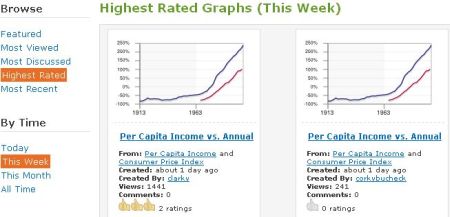von Roland Hachmann | Dez. 7, 2006 | Blog, Digital Culture, Digital News
I love how you can manipulate or remix datasources in all sorts of ways to achieve „conclusions“ of your choice. This graph, for example shows, that apple is more successful at lower temperatures:

This is from Swivel, a new „community“ for data analysts. You can upload your own data remix, rate other people’s graphs. It’s all the web 2.0 stuff you expect but this time not for pictures, videos or other cool stuff, but rather data. Just data. And of course a lot of graphs.

So is this site of any particular use? – I don’t think so.
Will it attact huge crowds like YouTube did? – Not likely.
von Roland Hachmann | Dez. 6, 2006 | Ad News, Blog, Digital Marketing, Digital News, Online Advertising
Marketers Websites attract more eyeballs than other media, according to AdAge:
Believe it or not, those boring corporate websites are pulling in more eyeballs — and more influencers — than the flashy prime time TV shows, print magazines and general interest sites on which marketers advertise.
In figures, to be precise:
Yet the websites of P&G and Unilever now reach nearly 6 million and 3 million unique visitors, respectively, in the U.S. each month, according to ComScore Media Metrix.
But it’s not only about more eyeballs, these eyeballs are also quite interesting for marketers, as they are usually influencers, or at least people who actively engage with the brand in considerable numbers.
Their engagement with corporate and brand sites is well above the norm for the general population. „Visitors to [corporate and brand] websites have a much higher propensity to recommend products,“ said Pete Blackshaw, chief marketing officer of Nielsen Buzzmetrics, whose research shows more than 40% of people who give a brand e-mail feedback are likely to recommend it to others.
Much of it is derived from „regular“ online Advertising:
Much of the traffic to the big package-goods marketers‘ sites appears to be coming the way originally envisioned in the online advertising model: as a response to online display advertising. Search-heavy Google accounts for a relatively small amount of traffic to the P&G and Unilever sites compared with display-ad-heavy Yahoo
That doesn’t surprise me at all, since most of P&Gs and Unilevers products are FMCG, for which I assume users usually don’t search much. Or if people do search for these kind of things, then the FMCG companies haven’t found the right way to effectively keyword advertise.
von Roland Hachmann | Dez. 4, 2006 | Blog, Digital Marketing, Digital News, Online Advertising, Social Media Marketing
Micro Persuasion points me to a piece of research about the fact that:
The online world is just as important as the real world, feel a large portion of internet users in the United States. […] 43 per cent of internet users who are members of online communities „feel as strongly“ about their virtual community as their real world community.
I wonder if those figures are similar in Germany or Europe in general. What also means, especially for us marketers: build a strong community around your brand (in any way possible: blogs, forums, etc.) and you should – in theory – reach a certain level of relevance and „feel strongly“-factor for your brand.
von Roland Hachmann | Dez. 4, 2006 | Blog, Digital Culture, Digital News
TechCrunch writes about Boo.com launching again. Weren’t they the ones that „started“ the burst of the first bubble in 2000/2001?
In 1999 Boo.com, a fashion retail site, burnt through $120 million in six months […] Founded by Ernst Malmsten, Kajsa Leander and Patrik Hedelin, Boo.com’s largest backer was Omnia, a fund backed by members of Lebanon’s wealthy Hariri family, which put nearly $40 million into the company. Over 400 staff and contractors were made redundant when Boo went into receivership in May 2000.
Is it good or bad, if they come back? Not sure, but you better watch out 😉
(hat tip)
von Roland Hachmann | Dez. 3, 2006 | Blog, Digital Culture, Digital News, Social Media Marketing
An interesting post by Chiara Fox, a senior information architect on tagging vs. cataloging.
Tagging differs from traditional cataloging in a number of ways. First, tagging no longer belongs solely to the world of librarians and indexers: now anyone can tag and describe assets. And not only is it possible for any user to apply a tag, but in some systems (such as Flickr), users can even add tags to other peoples’ assets.
It’s nothing groundbreaking new, but a good summary of folksonomies vs taxonomies. My favourite quote:
tagging has brought metadata to the masses
von Roland Hachmann | Nov. 28, 2006 | Blog, Digital Culture, Digital News
PSFK lists the top 10 Viral Videos, at least according to the Times Online.
They are:
1 Star Wars Kid (viewed 900 million times)
2 Numa Numa (700m)
3 One Night in Paris (400m)
4 Kylie Minogue: Agent Provocateur (360m)
5 Exploding Whale (350m)
6 John West Salmon Bear Fight (300m)
7 Trojan Games (300m)
8 Kolla2001 (200m)
9 AfroNinja (80m)
10 The Shining Redux (50m)
I must admit I hadn’t seen most of these. And I just wonder, how „The Viral Factory“ measured these figures?
Interesting is one reaction of TV companies:
Television companies, losing viewers to the net, are now launching channels to show “viral videos�.
And apparently they need to react, since:
A BBC Online survey has found that the online video craze is eating into the time that young people spend watching television, with 43 per cent of those who watch video from the internet or on a mobile device at least once a week saying they now watch less normal television as a result.



 Wo ich sonst so bin...
Wo ich sonst so bin...